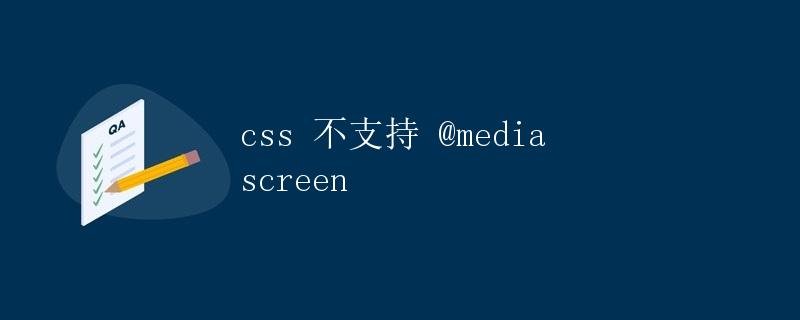CSS does not support @media screen
CSS does not support @media screen

In front-end development, we often use media queries (@media screen) to apply different styles based on the device’s screen size or other conditions. However, sometimes we may encounter browsers or CSS engines that do not fully support the @media screen media query. This article will explain in detail why CSS does not support @media screen and how to solve it.
Why doesn’t CSS support @media screen?
Over the past few years, CSS syntax and specifications have undergone numerous changes and evolutions. In early versions of CSS, there were no media query rules like @media screen . Later, with the proliferation of mobile devices and the rise of responsive web design, @media screen became an indispensable part of front-end development.
However, some older browsers or CSS engines may not fully support @media screen. This may be because the browser or engine developers haven’t updated and adapted the new CSS specifications in a timely manner, or because of bugs or incomplete implementations.
Also, some browsers may intentionally choose not to support certain CSS features to ensure performance and stability. In these cases, we need to find other solutions to accommodate non-support for @media screen .
How to fix CSS not supporting @media screen?
1. Use compatible CSS features
One solution is to avoid using @media screen as much as possible and instead use more universally supported CSS features to achieve the same effect. For example, you can use specific CSS class names to distinguish different screen sizes, and then set different styles for each class name in your style sheet.
/* When @media screen is not supported */
/* Small screen device styles */
.small-screen {
/* Style code */
}
/* Large screen device styles */
.large-screen {
/* Style code */
}
2. Dynamically adjust styles using JavaScript
Another solution is to use JavaScript to detect the device’s screen size and dynamically add appropriate styles to the page. While this method is relatively complex, it ensures proper display across various browsers and devices.
// Detect screen width
const screenWidth = window.innerWidth;
// Add appropriate class names based on screen width
if (screenWidth < 768) {
document.body.classList.add('small-screen');
} else {
document.body.classList.add('large-screen');
}
3. Browser Compatibility
Finally, if using @media screen is unavoidable and you encounter an unsupported browser or CSS engine, consider implementing browser compatibility measures. For example, you can use CSS hacks or polyfills to compensate for unsupported features.
Note that this approach may reduce code maintainability and readability, so use it with caution.
Conclusion
While it’s uncommon for CSS to not support @media screen, it can happen in certain situations. In this case, we can resolve the issue by using compatible CSS features, dynamically adjusting styles with JavaScript, or addressing browser compatibility. During development, timely testing and debugging are necessary to ensure that the page displays properly on various browsers and devices.